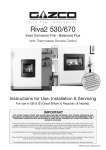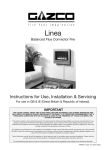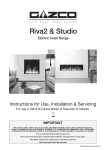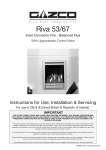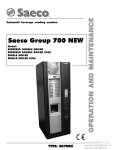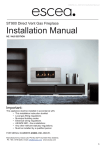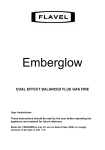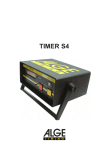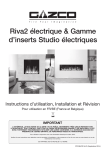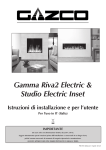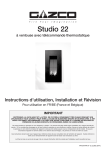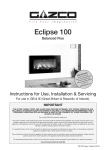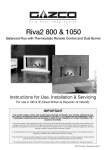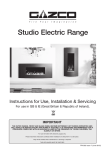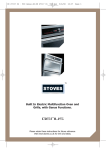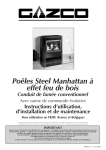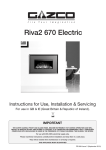Download Riva2 530 670 Conventional Flue Instructions
Transcript
Riva2 530/670 Inset Convector Fire - Conventional Flue with Thermostatic Remote Control T: RTAN O ow, l P l IM to fo asy ideo ep v to by st p how ste on s your ction u tr ins d maintain go to e an stem operat mote sy e or tv Gazc zco For e .Ga www . Instructions for Use, Installation & Servicing For use in GB & IE (Great Britain & Republic of Ireland). IMPORTANT THE OUTER CASING, FRONT AND GLASS PANEL BECOME EXTREMELY HOT DURING OPERATION AND WILL RESULT IN SERIOUS INJURY AND BURNS IF TOUCHED. IT IS THEREFORE RECOMMENDED THAT A FIREGUARD COMPLYING WITH BS 8423:2002 IS USED IN THE PRESENCE OF YOUNG CHILDREN, THE ELDERLY OR INFIRM. This product contains a heat resistant glass panel. This panel should be checked during Installation and at each servicing interval. If any damage is observed on the front face of the glass panel (scratches, scores, cracks or other surface defects), the glass panel must be replaced and the appliance must not be used until a replacement is installed. Under no circumstances should the appliance be used if any damage is observed, the glass panel is removed or broken. It is essential that ALL of the screws that retain the glass frame are replaced and tightened correctly. Under no circumstances should the appliance be operated if any of these screws are loose or missing. These Instructions must be left with the appliance for future reference and for consultation when servicing the appliance. Please make the customer aware of the correct operation of the appliance before leaving these instructions with them. The commissioning sheet found on Page 3 of this Instruction manual must be completed by the Installer prior to leaving the premises. PR2011 Issue 2 (March 2014) Contents Riva2 530/670 - Conventional Flue Covering the following models: Gas Type RIVA2 530 RIVA2 670 Nat. Gas 134-392 134-130 LPG 134-602 134-771 Appliance Commissioning Checklist.......................3 User Instructions........................................................4 Installation Instructions...........................................12 Technical Specifications ........................................................... 12 Site Requirements..................................................................... 13 Installation................................................................................. 16 Commissioning.......................................................................... 24 Servicing Instructions..............................................25 Fault Finding.............................................................................. 26 How to Replace Parts............................................................... 28 Basic Spare Parts List............................................................... 33 Service Records........................................................................ 34 2 To receive your Extended Warranty your Gazco appliance must have been purchased from our Expert Retailer Network and registered within one month of purchase or installation. Please note that all warranties are effective from the date of purchase. Any Gazco product purchased outside of our Extended Retailer Network, or not registered within the stated time will carry a standard 12 month warranty. It is a condition of the Extended Warranty that the installation complies with the relevant Building Regulations and is carried out by a suitably trained and qualified individual (GasSafe in the UK or equivalent in other countries) with the certificate of installation and the Commissioning Report on Page 3 completed and retained by the end user. Full terms and conditions are detailed in the Warranty Statement on the Gazco website www.gazco.com. In the event of any conflict of information the wording on the website shall prevail. Important Note: Should any problems be experienced with your product, claims must first be submitted to the Expert Retailer where the appliance was purchased from who will offer immediate assistance or contact Gazco on your behalf. Appliance Commissioning Checklist To assist us in any guarantee claim please complete the following information:- IMPORTANT NOTICE Explain the operation of the appliance to the end user, hand the completed instructions to them for safe keeping, as the information will be required when making any guaranteed claims. FLUE CHECK PASS FAIL 1. Flue Is correct for appliance 2. Flue flow Test 3. Spillage Test GAS CHECK 1. Gas soundness & let by test 2. Standing gas pressure mb 3. Appliance working pressure (on High Setting mb 4. Gas rate m3/h NB All other gas appliances must be operating on full 5. Does Ventilation meet appliance requirements N/A SAFETY CHECK 1. Glass checked to ensure no damage, scratches, scores or cracks. 2. Glass frame secured correctly and all screws replaced RETAILER AND INSTALLER INFORMATION Retailer. . . . . . . . . . . . . . . . . . . . . . . . . . . . . . . . . . . . . . . . . . . . . . . Installation Company. . . . . . . . . . . . . . . . . . . . . . . . . . . . . . . . . . . . . . . . . . . . . . . . . . . . . . . . . . . . . . . . . . . . . . . . . . . . . . . . . . . . . . . . . . . . . . . . . . . . . . . . . . . . . . . . . . . . . . . . . . . . . . . . . . . . . . . . . . . . . . . . . . . . . . . . . . . . . . . . . . . . . . . . . . . . . . . . . . . . . . . . . . . . . . . . . . . . . . . . . . . . . . . . . . . . . . . . . . . . . . . . . . . . . . . . . . . . . . . . . . . . . . . . . . Contact No.. . . . . . . . . . . . . . . . . . . . . . . . . . . . . . . . . . . . . . . . . . . Engineer. . . . . . . . . . . . . . . . . . . . . . . . . . . . . . . . . . . . . . . . . . . . . Date of Purchase. . . . . . . . . . . . . . . . . . . . . . . . . . . . . . . . . . . . . Contact No.. . . . . . . . . . . . . . . . . . . . . . . . . . . . . . . . . . . . . . . . . . Model No. . . . . . . . . . . . . . . . . . . . . . . . . . . . . . . . . . . . . . . . . . . . . Gas Safe Reg No. . . . . . . . . . . . . . . . . . . . . . . . . . . . . . . . . . . . Serial No.. . . . . . . . . . . . . . . . . . . . . . . . . . . . . . . . . . . . . . . . . . . . . Date of Installation. . . . . . . . . . . . . . . . . . . . . . . . . . . . . . . . . . Gas Type. . . . . . . . . . . . . . . . . . . . . . . . . . . . . . . . . . . . . . . . . . . . . 3 User Instructions Welcome Congratulations on purchasing your Riva2 fire, if installed correctly Gazco hope it will give you many years of warmth and pleasure for which it was designed. The purpose of this manual is to familiarise you with your appliance, and give guidelines for its installation, operation and maintenance. If, after reading, you need further information, please do not hesitate to contact your Gazco retailer. 1.4 No furnishings or other objects should be placed within 1 metre of the front of the appliance. 1.5 If a shelf is fitted, a distance of 150mm above the appliance is required. 1.6 If any cracks appear in the glass panel do not use the appliance until the panel has been replaced. 1.7 This product is guaranteed for 5 years from the date of installation, as set out in the terms and conditions of sale between Gazco and your local Gazco Retailer. Please consult with your local Gazco Retailer if you have any questions. In all correspondence always quote the Model Number and Serial Number. WARNING In the event of a gas escape or if you can smell gas, please take the following steps: • Immediately turn off the gas supply at the meter/emergency control valve 2. Operating the Appliance The appliance is operated by thermostatic remote control. 1 • Extinguish all sources of ignition • Do not smoke • Do not operate any electrical light or power switches (On or Off) Up Down • Ventilate the building(s) by opening doors and windows • Ensure access to the premises can be made Please report the incident immediately to the National Gas Emergency Service Call Centre on 0800 111 999 (England, Scotland and Wales) , 0800 002 001 (N. Ireland) or in the case of LPG, the gas supplier whose details can be found on the bulk storage vessel or cylinder. The gas supply must not be used until remedial action has been taken to correct the defect and the installation has been recommissioned by a competent person. 2.1 Turning the appliance On Your remote can control the gas fire from pilot ignition through to shut down. To turn the fire on press the OFF button and the UP button simultaneously. You hear several short signals. The pilot and main burner ignite and the remote is now in Manual Mode: 1. General 1.1 Installation and servicing must only be carried out by a competent person whose name appears on the Gas Safe register. To ensure the engineer is registered with Gas Safe they should possess an ID Card carrying the following logo: 1.2 In all correspondence, please quote the appliance type and serial number, which can be found on the data badge located on a plate attached to the lower slotted trim. 1.3 Do not place curtains above the appliance: You must have 300mm (1’) clearance between the appliance and any curtains at either side. 4 IMPORTANT: YELLOW FLAMES TYPICALLY APPEAR WHEN THE APPLIANCE HAS REACHED NORMAL OPERATING TEMPERATURE. THIS CAN TAKE UP TO 30 MINUTES. WARNING: IF THE APPLIANCE FAILS TO LIGHT OR BECOMES EXTINGUISHED IN USE, WAIT 3 MINUTES BEFORE ATTEMPTING TO RELIGHT. 2.2 There are 3 different modes available for controlling and operating the appliance: 1. Manual Mode 2. Temp Mode (Automatic) 3. Timer Mode (Automatic) User Instructions 2.3In MANUAL MODE you can: —turn on the main burner using the UP button —regulate the flame from high to low and back —turn off the burner leaving just the pilot burning In TEMP MODE (Automatic) you can: —set the room temperature so the thermostat in the remote automatically maintains that temperature In TIMER MODE (Automatic) the fire: —turns on and off according to the set time periods —automatically regulates the room temperature during the set periods NOTE: When operating the fire in Temp or Timer mode, the pilot remains lit and the fire then automatically switches on at programmed times to bring the room to the set temperature whether or not you are in the room. NEVER LEAVE ANY COMBUSTIBLE MATERIALS WITHIN 1 METRE OF THE FRONT OF THE APPLIANCE. Temp Mode (Automatic) 2.6 The display shows the current room temperature. To increase or decrease the fire’s output: Press the SET button to select either the DAY TEMP or the NIGHT TEMP mode by briefly pressing the SET button. Hold the SET button until the TEMP display flashes and then let go. Set the desired temperature with the UP and DOWN arrows. (Minimum temperature 5C, maximum 40C or 40F to 99F when Fahrenheit is the preferred option) Press the OFF button to stop the display flashing or wait to return to TEMP mode. NOTE: If you set a temperature that is beneath the current room temperature, the fire automatically switches to PILOT (Stand by). Switching Between Modes Press the SET button to change to Temperature Mode. Press again to change to Timer Mode. Keep pressing to run through all operating modes. These are: —MAN —DAY TEMP —NIGHT TEMP —TIMER and back to MAN If you would like the Night temperature control to turn off then decrease the temperature until [--] is displayed. 2.4 Timer Mode (Automatic) 2.7 NOTE: MAN mode can also be reached by pressing either the UP or DOWN button. Manual Mode 2.5 Press the OFF button and the UP button simultaneously. You hear several clicks and audible beeps as the fire begins the ignition process, (up to 30 seconds). There are two programmable settings you can make over a 24 hour period, P1 and P2. These are normally used to provide an early morning and evening setting for each working week: P1 P1 P2 P2 + + + + = Start Timed Setting 1 = End of Timed Setting 1 = Start Timed Setting 2 = End of Timed Setting 2 2.8 P1 - Program 1 for a Timed Setting Turning the appliance Off: Press the SET button until the TIMER mode is displayed. Press the OFF button to turn the appliance off FOR SAFETY, YOU MUST WAIT 30 SECONDS BEFORE LIGHTING THE FIRE AGAIN. Hold the SET button. The displays flashes the current time for P1. While the time displayed is flashing you can alter the hours and minutes set. Increasing the Flame Height: Press the UP button once to increase flame height one stage. Press and hold the UP button to increase to maximum. Decreasing the Flame Height: Press the DOWN button once to decrease flame height one stage. Press and hold the DOWN button to decrease to minimum. At the lowest point the fire goes to 'Standby Mode' (Only Pilot lit). NOTE: While pressing a button a symbol indicating transmission appears on the display. The receiver confirms transmission with a sound signal. To set the time your fire first lights, change P1 — Press the UP button to alter the hour. — Press the DOWN button to alter the minutes in 10 minute increments. Press SET again to move to the end setting for P1 This is the time your Studio first shuts down: — Press the UP button to alter the hour. — Press the DOWN button to alter the minutes. 2.9 P2 - Program 2 for a Timed Setting Use the same steps outlined in 2.8 to change the setting for P2. If you have already set P1 and want to alter the setting for P2 only: 5 User Instructions —Press the SET button until TIMER mode is displayed. —Hold the SET button until the display flashes the current time for P1 . —Press the SET button once again to scroll past the settings for P1 and P1. With the time still flashing: —Press the UP button to alter the hour. —Press the DOWN button to alter the minutes. Once all four times are set press the OFF button. 3.2 Slide the cover forward, see Diagram 3. 3 2.10 To view existing settings: —Select Timer Mode —Press and briefly hold the SET button you see the start time for P1 —Repeat the above step for the start and end of each program. Low Battery 3.3 Remove the old batteries and correctly position the 4 new high quality (Duracell or similar) AA size batteries into the battery compartment. 3.4 Re-assemble in reverse. 4. Cleaning the Appliance “BATT” is displayed on the remote when its batteries need replacement. Setting the time Simultaneously press the up and down buttons. Press the up button to set the hour and the down button to set the minutes. Press OFF to return to the manual mode or simply wait. 4.1 To remove the decorative front from the appliance please refer to the separate instructions supplied with the front. 4.2 Remove the glass frame by unscrewing the 6 screws, see Diagram 4. 4 Setting the °C/24 Hour or °F/12 Hour clock Press OFF and the down arrow until the display changes from °C/24 hour clock to °F/12 hour clock and vice versa. If the remote is removed, lost or damaged, signals transmitted to the receiver cease. Your fire will go to standby (pilot) mode after 6 hours. 3. Changing the Appliance Batteries 3.1 The batteries are located in the control box in the base of the front of the appliance, see Diagram 2. 2 4.3 Remove the liners and logs, and place them on a dry, clean surface. 4.4 The logs should not require cleaning. Do not use a vacuum cleaner or brush to clean the logs, any large pieces of debris may be removed by hand. 4.5 Ensure any debris is removed from the burner ports. 4.6 Replace the liners by referring to Section 5. 4.7 Use a damp cloth to clean the outer casing of the appliance. 4.8 To clean the glass surface, Gazco recommends you use a ceramic glass product generally sold for cleaning ceramic hobs. 4.9 The glass frame must be refitted to the appliance following cleaning or servicing. Control Box 6 User Instructions 4.10 Ensure that the fibreglass seal on the back of the glass frame is intact then hook the location tabs over the hooks on top of the firebox. Replace the 6 screws working from the top down. Tighten the screws evenly DO NOT OVER TIGHTEN, see Diagram 10. NEVER OPERATE THE APPLIANCE WHEN THE GLASS FRAME IS REMOVED OR BROKEN. 4.11 Replace ALL of the securing screws ensuring that a screw is present in all fixing slots. UNDER NO CIRCUMSTANCES SHOULD THE APPLIANCE BE USED IF ANY OF THE GLASS FRAME RETAINING SCREWS ARE LOOSE OR MISSING 5. Removal & Fitting of the Liners 5.1 The Riva2 appliance comes with three optional liner finishes: Vermiculite Black Reeded Brick Effect 5.2 To fit the desired liner type remove the retaining bracket at the top rear of the firebox, see Diagram 5. 5 4.12 Replace the decorative front by referring to the separate instructions supplied with the front. NOTE: ENSURE THAT THE LOGS ARE POSITIONED CORRECTLY, SEE SECTION 6. ONLY USE THE CORRECT AMOUNT OF LOGS AS SPECIFIED IN THE DIAGRAMS. Advice on handling and disposal of fire ceramics The side panels in this appliance are made from Refractory Ceramic Fibre (RCF), a material which is commonly used for this application. Protective clothing is not required when handling these articles, but we recommend you follow normal hygiene rules of not smoking, eating or drinking in the work area and always wash your hands before eating or drinking. To ensure that the release of RCF fibres are kept to a minimum, during installation and servicing a HEPA filtered vacuum is recommended to remove any dust accumulated in and around the appliance before and after working on it. When servicing the appliance it is recommended that the replaced items are not broken up, but are sealed within heavy duty polythene bags and labelled as RCF waste. RCF waste is classed as stable, non-reactive hazardous waste and may be disposed of at a licensed landfill site. Excessive exposure to these materials may cause temporary irritation to eyes, skin and respiratory tract; wash hands thoroughly after handling the material. Retaining Bracket Screws 5.3 Slide the back liner panel over the bracket in the base of the firebox and stand upright against the back of the appliance, see Diagram 6. 6 Bracket Liner 5.4 Replace the top retaining bracket to hold the back panel in place. 5.5 Slide the two side liners into place between the side of the firebox and the burner tray, see Diagram 7. 7 5.6 Removal of the liners is the reverse of this process. 7 User Instructions 6. Arrangement of Fuel Bed Components Riva2 530 Layout 6.1 The logs for the fuel bed are clearly individually labelled, see Diagram 8. 6.4 Place Log G on top of Log A. There is a hole on the underside of Log G which fits over the raised stud on Log A to secure in place. The end of the log sits on the raised section of the burner tray, see Diagram 11. 11 8 A G F 6.5 H 6.2 I K Place log A on the left hand front of the burner. The log will fit over the raised stud and into the raised stud and into the groove in the burner tray see Diagram 9. Place Log H on the centre of the burner tray. There is a raised stud in the fuel bed which securely locates the log in place. The right hand side rests on the raised section at the end of the air cutout, see Diagram 12. 12 9 6.6 13 6.3 Place Log F behind the Log A on the flat plain and locate the rear of the log on the metal bracket. The log should rest between the lip of the bracket and the rear liner, see Diagram 10. 10 View without Log A Flat plain 8 Rest Log I on the raised stud on Log H. The rear of the effect should rest in the groove at the back of the burner tray, see Diagram 13. 6.7 Sit the first hole in the bottom of the left hand side of Log K on the stud of Log H and secure by fitting the middle hole on the right hand side over the stud in the fuel bed by the burner port, see Diagram 14. 14 User Instructions Riva2 670 Layout 6.10 The logs for the fuel bed are clearly individually labelled, see Diagram 17. 17 6.8 Log K should rest on the flat plain behind the stud for the Log arrangement to be complete, see Diagram 15. 15 A F B C D E 6.11 Place log A on the left hand front of the burner. The log will rest in a groove and the raised stud will fit in the cut out notch in the log, see Diagram 18. Ensure the log is pushed as far to the side of the appliance as the grooves will allow. 18 6.9 Lay emberglow over the small ports in the base of the burner tray. This will create a glowing effect when the appliance is lit, see Diagram 16. 16 6.12 Place log F behind the first log and locate the rear of the log on the metal bracket. The log should rest between the lip of the bracket and the rear liner, see Diagram 19. 19 9 User Instructions 6.13 Place log B on top of log A. There is a hole on the underside of log B which fits over the raised stud in log A to secure in place, see Diagram 20. 6.16 Sit the hole in the bottom of Log E on the stud of Log D and rest the other end in the groove in the fuel bed by the burner port, see Diagram 23. 20 6.14 Place log C on the centre of the burner tray. There is a raised stud in the fuel bed which securely locates the left hand side of the log in place whilst the right hand side rests in the channel to the right hand side of the air cutout in the fuel bed, see Diagram 21. 23 6.17 Lay emberglow over the small ports in the base of the burner tray. This will create a glowing effect when the appliance is lit, see Diagram 24. 24 21 6.15 Rest log D on the raised stud on log C. The rear of the effect should rest against the back liner, see Diagram 22. 22 10 NOTE: ENSURE THAT THE LOGS ARE POSITIONED AS ABOVE. ONLY USE THE CORRECT AMOUNT OF LOGS AS SPECIFIED IN THE DIAGRAMS. User Instructions 7. Oxygen Depletion Sensor 8.1 The appliance is fitted with an oxygen sensitive pilot system that will act to cut off the gas supply to the appliance should the oxygen in the room fall below its normal level. If the appliance is turned off by this device it usually indicates that there is a problem with the flue system, this should be inspected by a qualified engineer. 13.1 Parts of this appliance become hot during normal use. 13.2 Regard all parts of the appliance as a working surface. 13.3 Provide a suitable fire guard to protect young children and the infirm. DO NOT ATTEMPT TO USE THE APPLIANCE UNTIL AN ENGINEER SAYS IT IS SAFE TO DO SO. THIS DEVICE IS NOT A SUBSTITUTE FOR AN INDEPENDENTLY MOUNTED CARBON MONOXIDE DETECTOR. 25 8. Flame Failure Device = Hot Surface This is a safety feature incorporated on this appliance which automatically switches off the gas supply if the pilot goes out and fails to heat the thermocouple. IF THIS OCCURS DO NOT ATTEMPT TO RELIGHT THE APPLIANCE FOR 3 MINUTES. 9. Running In 9.1 13. Hot Surfaces During initial use of a new Gazco appliance a strong odour will be encountered as various surface coatings become hot for the first time. Although these odours are harmless it is recommended that the appliance is operated on maximum for 4 to 8 hours in order to fully burn off these coatings. After this period the odours should then disappear. If the odours persists, please contact your installer for advice. 9.2 During the first few hours of burning there may be discolouration of the flames. This will also disappear after a short period of use. 14. Appliance will not light If you cannot light the appliance: 14.1 Check and change the batteries in the remote handset. 13.2 Check and change the control box batteries (see Section 3). 14.3 Consult your Gazco Retailer or installer if the Studio still does not light. 10. Servicing 10.1 The appliance must be serviced every 12 months by a qualified Gas Engineer. In all correspondence always quote the Model number and the Serial number which may be found on the data badge. 11. Ventilation 11.1 Any purpose provided ventilation should be checked periodically to ensure that it is free from obstruction. 12. Installation Details 12.1 Your installer should have completed the commissioning sheet at the front of this book. This records the essential installation details of the appliance. In all correspondence always quote the Model number and Serial number. 11 Installation Instructions Technical Specification Covering the following models: Gas Type RIVA2 530 RIVA2 670 Nat. Gas 134-392 134-130 LPG 134-602 134-771 Model Gas CAT. Gas Type Working Pressure Aeration Injector Gas Rate m3/h Riva2 530 I2H Natural (G20) 20mb 2x 4mm Ø 390 Riva2 530 I3P Propane (G31) 37mb 2 x 8mm Ø Riva2 670 I2H Natural (G20) 20mb Riva2 670 I3P Propane (G31) 37mb Input kW (Gross) Country High Low 0.647 6.8 3.9 GB, IE 128 0.256 6.8 3.7 GB, IE 2 x 4mm Ø 390 0.647 6.8 3.9 GB, IE 2 x 12mm Ø 128 0.252 6.7 3.7 GB, IE Efficiency Class 2 - 75% / NOx Class 4 Flue Outlet Size Ø 127mm Gas Inlet Connection Size Ø 8mm Minimum Flue Specification = T260/N2/0/D/1 Maximum Flue Temp = 225°C The net efficiency of this appliance has been measured as specified in EN613:2001 and the result after conversion to gross using the appropriate factor from Table E4 of SAP 2009 is 69%. The test data has been certified by Kiwa Nederland BV. The gross efficiency value may be used in the UK Government's Standard Assessment Procedure (SAP) for energy rating of dwellings. This appliance has been certified for use in countries other than those stated. To install this appliance in these countries, it is essential to obtain the translated instructions and in some cases the appliance will require modification. Contact Gazco for further information. Riva2 530 93 534 398 50 38 339 660 PACKING CHECKLIST Qty Description Fixing kit containing 1 x Cassette and burner assembly 1 x Decorative frame (if supplied) 1 x Back panel 1 x LH side panel 1 x RH side panel 1 x Log set (6 logs) 1 1 4 4 1 1 4 1 x Instruction manual x Quick Start Guide x Woodscrews x Wall plugs x Self adhesive foam strip x Handset x AA cell batteries x 9v cell battery 40 Riva2 670 93 659 524 38 339 OPTIONAL KITS 12 • Debris Deflector 8736 • Warm Air Ducting Kit 8572 50 525 40 Installation Instructions Site Requirements 1. Flue & Chimney Requirements 1 WHEN INSTALLING A FLUE SYSTEM PLEASE REFER TO THE MANUFACTURERS INSTRUCTIONS. Due to European chimney standards, new flue’s and chimney’s are described by their temperature, pressure and resistance to corrosion, condensation and fire. To assist in identifying the correct flue system, the minimum flue specification is shown in the Technical Specification. Existing chimneys are not covered by this system. 1.1 The chimney or flue system must comply with the rules in force, and must be 127mm (5") in diameter. Suitable systems are: 1.1.1 Within an existing masonry fireplace and chimney: a) Flexible liner which must be continuous from the appliance spigot to the roof terminal. b) Gazco Debris Deflector kit. UNDER NO CIRCUMSTANCES MUST THE DEBRIS DEFLECTOR KIT BE USED WITH ANY INSTALLATION OTHER THAN AN EXISTING MASONRY CHIMNEY WHICH HAS A MINIMUM DIAMETER OF 178mm (7”). THE CHIMNEY MUST BE SOUND AND CLEAN. IF PREVIOUSLY USED FOR SOLID FUEL, IT MUST BE SWEPT PRIOR TO PROCEEDING WITH THE INSTALLATION. NOTE: If the Debris Deflector kit is to be used, due care should be taken to prevent condensation forming in the chimney. Do not fit the Debris Deflector kit if the chimney is taller than 10 metres (external wall) or 12 metres (internal wall). Flexible or Rigid Liner 2. Gas Supply Debris Deflector This appliance is intended for use on a gas installation with a governed meter. 2.1 Before installation, ensure that the local distribution conditions (identification of the type of gas and pressure) and the adjustment of the appliance are compatible. 2.2 Ensure the gas supply delivers the required amount of gas and is in accordance with the rules in force. 2.3 Soft copper tubing can be used to install the appliance. Soft soldered joints can be used externally of the appliance but must be restricted to the area shown in Diagram 2. 2 1.1.2 Within a false chimney breast: a) Single or twin wall rigid flue pipe. 1.2 The minimum effective height of the flue must be 3 metres (10ft). 1.3 The flue must be free from any obstruction. Any damper plates should be removed or secured in the fully open position and no restrictor plates should be fitted. 1.4 The chimney should be swept immediately prior to the installation of the appliance. However, where it can be seen that the chimney is clean and unobstructed throughout its entire length, it need not be swept. 1.5 The Riva2 is designed so that the internal parts can be removed from the outer casing to make installation easier. This allows the liner or Debris Deflector to be connected and positioned within the chimney after the outer skin has been installed. 2.4 This appliance is supplied complete with a factory fitted isolation device incorporated into the inlet connection, no further isolation device is required. 2.5 All supply gas pipes must be purged of any debris that may have entered, prior to connection to the appliance. 2.6 The gas supply enters through the silicone panel located on the RH side of the outer box; this will need to be slit with a sharp knife prior to passing the supply pipe through. 13 Installation Instructions Site Requirements 4.4 IMPORTANT: Ensure any national ventilation requirements are taken into account during installation of the appliance. UK ONLY: This appliance has a nominal input not exceeding 7.0kW and does not normally require any additional permanent ventilation. 200 This appliance is not suitable for installation onto a combustible wall; all combustible materials must be remove from the area shown in Diagrams 3b and 3c. If however, spillage is detected when commissioning the appliance, there may be insufficient natural ventilation and additional ventilation may be required. 700 3. Ventilation 855 FOR THE REPUBLIC OF IRELAND REFER TO THE RULES IN FORCE FOR VENTILATION REQUIREMENTS. NOTE: If this appliance is fitted less than 150mm from the floor, then it will require a hearth to protect the floor. The hearth should have a minimum dimension of 12mm thick, projecting 300mm in front and 150mm either side of the appliance. If a Verve frame is to be fitted the appliance MUST be fitted at least 150mm above the floor. The minimum opening dimensions are shown in Diagram 3a. 980 Riva2 670 710 4.1 3c 555 150 4. Appliance Location 150 560 Riva2 530 900 3b 150 3a 680 STUDWORK INSTALLATION DIMENSION Riva2 530 Riva2 670 A 540mm 670mm B 350mm 350mm C 665mm 530mm 4.2 This appliance must not be installed in a room that contains a bath or shower. 4.3 NOTE: If using natural materials for the back panel of the fireplace, it is recommended that you construct it from three or more sections to prevent cracking. Resinbased materials may not be suitable. This appliance is an effective heat producer and attention must be paid to the construction and finish of the fireplace. 14 4.5 If a studwork installation is used (eg. wooden framework and plasterboard), combustible parts of the studwork must not be any closer than the minimum dimensions shown in the diagrams. NOTE: These dimensions must be maintained even if the combustible materials is protected by noncombustible linings. 4.6 Do not pack the void around or above the appliance with insulation materials such as mineral wool. 4.7 The void into which the cassette is fitted must be ventilated to prevent a build up of heat. If the void is sealed then it will be necessary to fit vents at both low and high levels of approximately 50cm2 each. These vents should take cold air from the room and return warm air back into the room. 4.8 A removable access hatch must be left in the side of the chimney breast for future servicing and inspection of the appliance. Installation Instructions Site Requirements 4.9 4 Build the studwork chimney breast to the desired size. Ensure that the clearances to combustible materials is maintained. Riva2 530 MINIMUM COMBUSTIBLE MATERIAL CLEARANCES FOR Riva2 530 5 Riva2 670 MINIMUM COMBUSTIBLE MATERIAL CLEARANCES FOR Riva2 670 It is recommended that a marble slip or similar material is used when fitting cassette fireplaces into a plastered surface, in order to allow for heat dissipation. Also allow adequate time for newly plastered areas to dry out. Rapid drying can create cracks. If in doubt, seek the advice of a professional plasterer. Parts of this appliance become hot during normal use. It is therefore recommended that a suitable fire guard be used for protection of young children and the infirm. 15 Installation Instructions 1. Safety Precautions 1.1 For your own and other’s safety, you must install this stove according to local and national codes of practice. Failure to install the stove correctly could lead to prosecution. Read these instructions before installing and using this appliance. 1.2 These instructions must be left intact with the user. 1.3 Do not attempt to burn rubbish on this appliance. 1.4 Keep all plastic bags away from young children. 1.5 Do not place any object on or near to the appliance and allow adequate clearance above the appliance. IF THE APPLIANCE IS EXTINGUISHED OR GOES OUT IN USE, WAIT 3 MINUTES BEFORE ATTEMPTING TO RELIGHT THE APPLIANCE. 1.6 The appliance is fitted with an oxygen sensitive pilot that will act to cut off the gas supply to the appliance in the event of incorrect operation of the flue. If the system acts to shut off the gas supply, this indicates that there is insufficient flue pull. Continued operation of this safety device means that there may be a serious problem with the flue system, and this should be inspected by a qualified gas engineer. Do not use the appliance until an engineer says it is safe to do so. The oxygen sensitive pilot must not be tampered with. Use only genuine Gazco replacement parts when servicing the appliance - refer to Servicing section. 2. Installation of the Appliance IMPORTANT: REFER TO DATA BADGE AND TECHNICAL SPECIFICATION AT THE FRONT OF THE MANUAL TO ENSURE THE APPLIANCE IS CORRECTLY ADJUSTED FOR THE GAS TYPE AND CATEGORY APPLICABLE IN THE COUNTRY OF USE. FOR DETAILS OF CHANGING BETWEEN GAS TYPES REFER TO SERVICING, SECTION 10, REPLACING PARTS. NOTE: There is an optional duct kit (GAZCO PART NUMBER 8572) which must be installed at the same time as the appliance installation. Please note: As an optional extra Gazco can provide a mains adapter to supply constant power to the appliance control box instead of the battery pack. 2.1 If installing an appliance with the adapter make provision for a mains power socket within 1.5m of the control box and follow the instructions provided. Remove the glass door by unscrewing the 6 x retaining screws, see Diagram 1. Carefully remove the box containing the logs from the firebox. Place to one side as these are fragile. The ceramic panels are factory fitted, take care not to damage these components. 1 2.2 The gas supply enters through the silicone panel located on the right-hand side of the outer box; this will need to be slit with a sharp knife prior to passing the supply pipe through, see Diagram 2. 2 Unpacking 1.7 Remove the appliance from its packaging, and check that it is complete and undamaged. Put the loose ceramic parts to one side so that they are not damaged during installation. 2.3 16 When installing the appliance into a combustible enclosure, ensure all the clearances are observed. Refer to Site Requirements, Section 4. Installation Instructions 3. Installation 3.1 When installing the appliance into a combustible enclosure, ensure all the clearances are observed. Refer to Site Requirements, Section 4. 3.2 The flue spigot on this appliance is suitable for connection to a 5” (127mm) flexible flue liner or rigid flue pipe. Alternatively, it can be fitted to the optional Gazco Debris Deflector. This removes the need for a flue liner. Note: Ensure that the flue is not subject to condensation, see Installation Section 1. 3.3 If a liner or the Debris Deflector is being fitted proceed as follows: 3.4 Remove the ceramic panels and log support as detailed in Servicing Instructions, Section 2. Remove the burner module and place safely to one side. 3.5 Remove the four screws securing the inner to the outer box and undo the two screws behind the rear ceramic panel, see Diagram 3. 3.8 Feed the gas supply through the right-hand side of the outer box, see Diagram 2 and slide the outer box backwards until its outer flange sits neatly onto the wall. Secure the outer box through the four fixing holes using the screws provided, see Diagram 5. 5 Flexible Liner 3.9.1 Remove the eight screws on the spigot plate, see Diagram 6. 3 6 3.6 Slide the inner box away from the outer box by pulling it forward, see Diagram 4. 4 3.7 3.9.2 Pull the liner through the hole in the top of the outer box and attach it to the flue spigot plate using the clip provided. Tighten the clip securely, see Diagram 7. 7 Remove the backing paper from the silicone foam strip supplied in the fixing kit and fix to the back of the outer flanges of the appliance, ensure that it is located below the frame location lugs on the top flange. 3.9.3 Secure the flue spigot plate to the inside top surface using the eight screws provided, see Diagram 6. 17 Installation Instructions Debris Deflector 3.10 Debris Deflector Assembly 3.12 Push the Debris Deflector up into the chimney and secure the flue spigot plate to the inside top surface using the eight screws provided, see Diagram 10. 10 Components: a) Flue pipe b) End terminal c) Clip d) Warning label 3.10.1 The flue pipe is supplied with tape around each end of the flue to protect your hands from the sharp edges. You must remove the tape before assembling the debris deflector. 3.10.2Place clip over one end of the flue pipe and insert the End Terminal inside of the flue pipe. Do not insert the End Terminal past the point shown in Diagram 8. 8 Do not attach flue past this point 3.13 Attach the label supplied with the Debris Deflector to the base of the appliance on the front right-hand side as shown. 11 3.10.3Tighten the clip until the End Terminal is secured firmly in place. 3.11 Attach the Debris Deflector to the flue spigot plate using the clip provided. Tighten the clip securely, see Diagram 9. 9 3.14 Locate the top of the inner box into the runners at the top of the outer box, see Diagram 12. 12 18 Installation Instructions 3.15 Gently slide the inner box into the outer box until the two flanges meet. Secure with the screws on the flange and the two screws on the inside rear surface as shown. Advice on handling and disposal of fire ceramics 13 The side panels in this appliance are made from Refractory Ceramic Fibre (RCF), a material which is commonly used for this application. Protective clothing is not required when handling these articles, but we recommend you follow normal hygiene rules of not smoking, eating or drinking in the work area and always wash your hands before eating or drinking. To ensure that the release of RCF fibres are kept to a minimum, during installation and servicing a HEPA filtered vacuum is recommended to remove any dust accumulated in and around the appliance before and after working on it. When servicing the appliance it is recommended that the replaced items are not broken up, but are sealed within heavy duty polythene bags and labelled as RCF waste. 3.16 Replace the burner module and secure in position. Replace the log support and ceramic panels as detailed in Replacing Parts, Section 2. 3.17 PURGE THE SUPPLY PIPE. This is essential to expel any debris that may block the gas controls. Connect the elbow to the appliance inlet pipe, see Diagram 14. RCF waste is classed as stable, non-reactive hazardous waste and may be disposed of at a licensed landfill site. 14 Excessive exposure to these materials may cause temporary irritation to eyes, skin and respiratory tract; wash hands thoroughly after handling the material. Elbow 5. Removal & Fitting of the Liners 5.1 4. Gas Soundness Pressure Check 4.1 Connect a suitable pressure gauge to the test point located on the inlet fitting and turn the gas supply on. Light the appliance and check all gas joints for possible leaks. Turn the appliance to maximum and check that the supply pressure is as stated on the databadge. Turn the gas off and replace the test point screw, turn the gas on and check the test point for leaks. The Riva2 appliance comes with three optional liner finishes: Vermiculite Black Reeded Brick Effect 5.2 To fit the desired liner type remove the retaining bracket at the top rear of the firebox, see Diagram 15. 15 Retaining Bracket Screws 19 Installation Instructions 5.3 Slide the back liner panel over the bracket in the base of the firebox and stand upright against the back of the appliance, see Diagram 16. 16 6.2 Place log A on the left hand front of the burner. The log will fit over the raised stud and into the raised stud and into the groove in the burner tray, see Diagram 19. 19 Bracket Liner 5.4 Replace the top retaining bracket to hold the back panel in place. 5.5 Slide the two side liners into place between the side of the firebox and the burner tray, see Diagram 17. 6.3 Place Log F behind the Log A on the flat plain and locate the rear of the log on the metal bracket. The log should rest between the lip of the bracket and the rear liner, see Diagram 20. 20 17 View without Log A Flat plain 6.4 5.6 Removal of the liners is the reverse of this process. 6. Arrangement Of Fuel Bed Components Riva2 530 Layout 6.1 The logs for the fuel bed are clearly individually labelled, see Diagram 18. 18 20 A F H I G K 21 Place Log G on top of Log A. There is a hole on the underside of Log G which fits over the raised stud on Log A to secure in place. The end of the log sits on the raised section of the burner tray, see Diagram 21. Installation Instructions 6.5 Place Log H on the centre of the burner tray. There is a raised stud in the fuel bed which securely locates the log in place. The right hand side rests on the raised section at the end of the air cutout, see Diagram 22. 6.8 Log K should rest on the flat plain behind the stud for the Log arrangement to be complete, see Diagram 25. 25 22 6.9 6.6 Rest Log I on the raised stud on Log H. The rear of the effect should rest in the groove at the back of the burner tray, see Diagram 23. Lay emberglow over the small ports in the base of the burner tray. This will create a glowing effect when the appliance is lit, see Diagram 26. 26 23 6.7 Sit the first hole in the bottom of the left hand side of Log K on the stud of Log H and secure by fitting the middle hole on the right hand side over the stud in the fuel bed by the burner port, see Diagram 24. 24 21 Installation Instructions 30 Riva2 670 Layout 6.10 The logs for the fuel bed are clearly individually labelled. See Diagram 27. 27 A F C D B E 6.14 Place log C on the centre of the burner tray. There is a raised stud in the fuel bed which securely locates the left hand side of the log in place whilst the right hand side rests in the channel to the right hand side of the air cutout in the fuel bed, see Diagram 31. 31 6.11 Place log A on the left hand front of the burner. The log will rest in a groove and the raised stud will fit in the cut out notch in the log, see Diagram 28. Ensure the log is pushed as far to the side of the appliance as the grooves will allow. 28 6.15 Rest log D on the raised stud on log C. The rear of the effect should rest against the back liner, see Diagram 32. 32 6.12 Place log F behind the first log and locate the rear of the log on the metal bracket. The log should rest between the lip of the bracket and the rear liner, see Diagram 29. 2299 6.16 Sit the hole in the bottom of Log E on the stud of Log D and rest the other end in the groove in the fuel bed by the burner port, see Diagram 33. 33 6.13 Place log B on top of log A. There is a hole on the underside of log B which fits over the raised stud in log A to secure in place, see Diagram 30. 22 Installation Instructions 6.17 Lay emberglow over the small ports in the base of the burner tray. This will create a glowing effect when the appliance is lit, see Diagram 34. 8. Lighting the Appliance 34 The appliance is operated by thermostatic remote control. 36 7. Completion of Assembly 7.1 Ensure that the fibreglass seal on the back of the glass frame is intact then hook the location tabs over the hooks on the top of the firebox. Replace the 6 screws working from the top down. Tighten the screws evenly. DO NOT OVER TIGHTEN, see Diagram 35. 35 This remote controls the appliance from pilot ignition through to shut down. In ‘MANUAL MODE’ you can: —light the pilot —turn on the main burner —regulate the flame from low to high and back —turn off the burner leaving just the pilot burning NEVER OPERATE THE APPLIANCE WHEN THE GLASS PANEL IS REMOVED OR BROKEN. 7.2 Replace ALL of the securing screws ensuring that a screw is present in all fixing slots. UNDER NO CIRCUMSTANCES SHOULD THE APPLIANCE BE USED IF ANY OF THE GLASS FRAME RETAINING SCREWS ARE LOOSE OR MISSING 7.3 In ‘TEMP MODE’ you can: —set the room temperature so the stove automatically maintains that temperature In ‘TIMER MODE’ the fire: —turns on and off according to the set time periods —automatically regulates the room temperature during the set periods 8.1 Turning the appliance On Your remote can control the gas fire from pilot ignition through to shut down. To turn the fire on press the OFF button and the UP button simultaneously. You hear several short signals. The pilot and main burner ignite and the remote is now in Manual Mode: Turning the appliance Off: Press the OFF button to turn the appliance off FOR SAFETY, YOU MUST WAIT 30 SECONDS BEFORE LIGHTING THE FIRE AGAIN. Replace the decorative front by referring to the separate leaflet supplied with the front. IMPORTANT: YELLOW FLAMES TYPICALLY APPEAR WHEN THE APPLIANCE HAS REACHED NORMAL OPERATING TEMPERATURE. THIS CAN TAKE UP TO 30 MINUTES. NOTE: ENSURE THAT THE LOGS ARE POSITIONED AS ABOVE. ONLY USE THE CORRECT AMOUNT OF LOGS AS SPECIFIED IN THE DIAGRAMS. WARNING: IF THE APPLIANCE FAILS TO LIGHT OR BECOMES EXTINGUISHED IN USE, WAIT 3 MINUTES BEFORE ATTEMPTING TO RELIGHT. FOR FULL OPERATING INSTRUCTIONS AND TROUBLESHOOTING SEE USER SECTION. 23 Commissioning 1. Commissioning If there are any extractor fans in the room or adjacent rooms, the test must be repeated with the fans running on maximum. IF SPILLAGE PERSISTS, DISCONNECT THE APPLIANCE AND SEEK EXPERT ADVICE. For future reference, record the installation details on the Commissioning Sheet on page 3. 1.1 Check the flame picture, log layout. 1.2 Check the gas pressure. 1.3 Close all door and windows in the room. 1.4 Ignite the Riva 2 and operate on maximum for 5 minutes. Reprogramming handset/Control box 1.5 Position a lighted smoke match just inside the draught diverter opening and check all smoke is drawn in along the opening. To access the control box see Servicing Instructions, Section 2 - Main Burner. If there is any doubt: —Press and hold the reset button on the control box until you hear two signals. After the second longer signal: 1.6 Run the appliance for a further 10 minutes and repeat the test, see Diagram 1. —Release the reset button and within 20 seconds: —Press the DOWN button on the handset until you hear two additional short signals confirming the new code is set. If there is a single long signal the code learning sequence has failed or the wiring is incorrect. 1 1.7 Complete the Commissioning Checklist at the front of this manual covering: — Flue checks — Gas checks — Log/fuel effect layout - flame picture 1.8 Upon completion of the commissioning and testing of the installation and correct operation of the appliance, the installer must instruct the user how to operate the appliance. 1.9 Guide the user through the User Instructions paying particular attention to: a) Regular servicing (Section 10 of the User Instructions). b) Ventilation (Section 11 of the User Instructions) - point out the ventilation positions where applicable. c) Hot surfaces (Section 13 of the User Instructions). d) How the appliance works with the remote control handset and the modes of operation (Section 2 of the User Instructions). e) How to change settings in the auto mode and program modes of operation. f) What to do if the appliance fails to operate (Section 14 of the User Instructions). 24 Servicing Instructions Servicing/Fault Finding Charts 1. Servicing Requirements IMPORTANT – The glass panel on this appliance should be checked for any signs of damage (scratches, scores, cracks or other surface defects). If damage is observed, the glass panel must be replaced and the appliance must not be used until a replacement is installed. Under no circumstances should the appliance be used if any damage is observed. Please isolate the appliance until a replacement glass panel has been obtained and installed. Replacement glass panels can be purchased from Gazco via the retailer from which the appliance was purchased or any other Gazco distributor. 1.6 Check if the appliance has been fitted with a Debris Deflector as indicated on the Appliance Commissioning Checklist on page 3 and a label attached to the base of the unit, see Diagram 1. If the appliance has been fitted with this device, then it is essential to remove the appliance to check the debris collection space immediately above the appliance inside the chimney, (see Replacing Parts, Section 12). 1 This appliance must be serviced at least once a year by a competent person. All tests must be carried out in accordance with the current Gas Safe recommendations. 1.1 Before Testing: —Conduct a gas soundness test for the property ensuring there are no leaks before servicing. —Check the operation of the appliance before testing. 1.2 Special checks: —Clean the burner using a vacuum cleaner with a soft brush attachment. Ensure all debris is removed from the burner ports. —Clean away lint or fluff from the pilot. —Clean away lint or fluff from under the burner. —Check the spark gap on the pilot is correct. — Ensure that the glass frame is secured correctly and that all retaining screws are in place. 1.3 Correct any faults found during the initial test. 1.4 Re-commission the appliance in accordance with Commissioning Procedures of these instructions. 1.5 Advise the customer of any remedial work undertaken. ELECTRONIC CONTROL VALVE FAULT ANALYSIS Symptom Cause Remedy 3 Short beeps from control Batteries low in appliance Replace appliance batteries No ignition, 5 second continuous tone (there may be several short beeps before) Loose/damaged wire Check interrupter block and wires No ignition, no tone, motor turns slightly when operated Receiver board damaged Replace receiver No pilot flame and control continues to spark Thermocouple circuit wired incorrectly Correct wiring Pilot lights, control continues to spark, value shuts down after 10 - 30 seconds 1. No spark at pilot burner 2. Loose/damaged wire 1. Rectify spark at pilot burner 2. Check interrupter and wires REPLACE BATTERIES BEFORE ATTEMPTING TO RECTIFY ANY FAULTS. 25 Servicing Instructions Fault Finding Charts Ignition Functional Check 1 PILOT WILL NOT LIGHT Ensure there is no debris around the pilot assembly, (e.g. soot, etc.) which could short the spark, clean the area. No Operate the valve control system in the manual mode via the touch pad or remote. Is there a spark? Yes Consult User Instructions and retry. No Yes Does the pilot light? No Is the control being operated correctly? Yes Check alignment of pilot burner head. Change the ignition lead, see Replacing Parts, Section 4. Yes Will the pilot light with a match? No Check isolation tap and gas meter, retry. No Is the gas turned on to the appliance? Yes Correct and retry. No Is the gas pressure correct? Yes Purge the gas pipes and retry. Yes Has the system got any air in it? No There is a blockage in the system, check the inlet test point, the mag seating and valve. Check thermocouple leads for correct orientation, condition and connection GO TO THE NEXT CHART IGNITION FUNCTIONAL CHECK 2 26 SYSTEM OK Replace the lead, retry. No Has the ignition lead become detached from the control box? No Replace the pilot unit Yes Correct and retry. Check the tab on the pilot burner is not damaged. Either repair tab or replace pilot burner and retry. Is the control system being operated correctly? Check handset batteries are OK. Replace if required. Check handset is on manual. Check if handset lock is off. Check batteries to the control unit. Replace if required. Retry with handset and touch pad (if applicable). Replace the ignition lead and retry. Yes Yes No No Remove the ignition lead from electrode. With insulated pliers. Hold the tip 4.0mm from the pilot pipe work, is there a spark when the system is operated? No Has ignition lead become detached or is connection poor? Yes Is the gap between electrode and thermocouple 4.0mm? Yes From Ignition Fault Finding Chart 1 Consult the users instructions, retry. Yes Change the pilot unit. No Is the pilot flame of the correct length? See Servicing Requirements Diagram 7 Yes No Yes With the pilot running is the gas pressure as stated on No the data badge? No SYSTEM OK Change mag unit. No Will pilot stay alight? No No No Yes Yes Replace pilot unit. Yes Is thermocouple connection good in back of valve? Problem is with the pipe work or fittings which lead to the appliance. Correct and retry. Will pilot stay alight? Yes Run for 3 mins, turn off, time interval until mag unit shuts with a click. Is this greater than 7 seconds? Tighten the connection and retry. Run for 3 mins, turn off, time interval until mag unit shuts with a click. Is this greater than 7 seconds? Yes With the appliance running on full is the gas at the pressure stated on the data badge? Light the pilot using either the handset or the touch pad (if applicable) Ensure there is no debris around the pilot assembly, (e.g. soot etc.) Check for fluff in the pilot aeration hole. See Section 3 in the Replacing Parts section. PILOT WILL NOT STAY LIT OR FIRE GOES OUT IN USE NO SPARK Ensure there is no debris around the pilot assembly, (e.g. soot etc.) which could short the spark, clean the area. Flame Failure Functional Check 3 Ignition Functional Check 2 No Yes Is the flue working? Rectify flue Yes Servicing Instructions Fault Finding Charts 27 Servicing Instructions - Replacing Parts 1. General 1.1 All main components can be replaced without removing the appliance from its installation. IT IS ESSENTIAL THAT THE GAS SUPPLY TO THE APPLIANCE IS TURNED OFF AT THE ISOLATION DEVICE BEFORE PROCEEDING FURTHER. 1.2 It will be necessary to remove the complete burner module before any of the components can be serviced. 2.8 Carefully slide the liners forward, see Diagram 2 and store safely (they are very fragile). 2 2. Main Burner 2.1 Turn the gas supply off at the isolation device. 2.2 To remove the decorative front from the appliance please refer to the separate instructions supplied with the front. 2.3 HAVE YOU ISOLATED THE GAS SUPPLY? 2.9 Disconnect the isolating device from the appliance inlet pipe so as to leave the gas supply isolated, see Diagram 3. Remove the glass frame, see Diagram 1. 3 1 Elbow 2.4 Place carefully to one side. 2.5 The glass frame must be refitted to the appliance following cleaning or servicing. Hold in position and secure with the screws 2.6 Replace ALL of the securing screws ensuring that a screw is present in all fixing slots. 2.10 Remove the 2 screws at the front of the burner tray and the 2 behind the burner fuel bed at the rear, see Diagram 4. 4 UNDER NO CIRCUMSTANCES SHOULD THE APPLIANCE BE USED IF ANY OF THE GLASS FRAME RETAINING SCREWS ARE LOOSE OR MISSING 2.7 Remove the decorative logs. 2.11 Carefully remove the fuel bed and place safely to one side. 28 Servicing Instructions - Replacing Parts 2.12 Hold the burner tray at the front, pull forward and rotate upwards. The unit can now be serviced. 2.13 When replacing the unit ensure the location tabs engage under the divider plate, see Diagram 5. 5 4. Ignition Lead 4.1 Gain access to the pilot assembly (see Section 2) and disconnect the ignition lead from the electrode. 4.2 The control box is secured to the bracket with velcro. Remove the control box from the bracket to ease access to the ignition lead connection, see Diagram 8. 813 Control Box 3. Pilot Unit 3.1 Undo the compression nut on the pilot burner then undo the thermocouple at the rear of the gas valve. Remove the ignition lead from the electrode, undo the two retaining screws and remove the pilot, see Diagram 6. 6 Ignition lead 4.3 Replace with a new ignition lead following the same route as the old one. Refit the Vidaflex cover over the ignition leads. Ensure the cover engages fully over the electrode. 4.4 When replacing the control box ensure no wires are trapped and check the operation of the new ignition lead. 4.5 Replace the main burner. 5. Gas Valve To change the gas valve: 5.1Disconnect the gas inlet pipe, see Diagram 9, Arrow A. 3.2 When replacing the pilot ensure the thermocouple follows its original route, i.e. along the pilot pipe. Attach the thermocouple to the pipe with new cable ties. 3.3 Set the spark gap, see Diagram 7. 7 15mm 5.2 Disconnect the gas outlet pipe, see Diagram 9, Arrow B. 5.3 Disconnect the pilot pipe, see Diagram 9, Arrow C. 5.4 Disconnect the thermocouple, thermocurrent wires and the interrupter block, see Diagram 9, Arrow D 5.5 Remove the eight wire loom, see Diagram 9 Arrow E. 9 4mm C D A E B 3.4 Check for gas leaks. 5.6 Remove the 2 screws securing the valve to the support bracket and withdraw the valve. Replace in reverse order. 29 Servicing Instructions - Replacing Parts 6. Magnetic Safety Valve 6.1 Remove the burner module as described in Servicing, Replacing Parts, Section 2. 6.2 Undo the thermocouple from the interrupter block and remove the two interrupter leads. 6.3 Unscrew the interrupter block from the back of the valve. 6.4 Undo the silver magnetic valve retaining nut on the back of the valve. 6.5 Gently tap out the mag valve. 6.6 Replace with a new unit. 6.7 Reassemble in reverse order ensuring that the interrupter leads are connected correctly with the blue tag lead furthest away from the gas valve body. 7. Control Box 7.1 7.5 After replacing the control box you may need to reprogram the handset. —Press and hold the reset button on the control box until you hear two signals. After the second longer signal: —Release the reset button and within 20 seconds: —Press the DOWN button on the handset until you hear two additional short signals confirming the new code is set. If there is a single long signal the code learning sequence has failed or the wiring is incorrect. 8. Main Injector 8.1 Remove the burner module as described in Servicing, Replacing Parts, Section 2. 8.2 Loosen and remove the nut from the injector pipe, see Diagram 11. 1113 Remove the burner module as described in Servicing, Replacing Parts, Section 2. 7.2 Remove the two thermocurrent cables by removing the two screws, Diagram 10. 7.3 Remove the ignition lead, Diagram 10. 7.4 Remove the eight wire loom from the control box. The control box can now be replaced. When replacing the sealing plate on the rear of the control cover use a suitable silicone sealant. 10 Injector Feed Pipe 8.3 Remove the Aeration plate by unscrewing the two nuts that hold the plate in place, see Diagram 12. 12 Eight wire cable Thermo current cables Ignition lead 8.4 Undo the 14mm lock nut that holds the pipe to the injector, see Diagram 13. 13 30 8.5 Replace with the correct size injector. 8.6 Check for leaks. Servicing Instructions - Replacing Parts 9. Primary Aeration Plate 11.4 Carefully slide the liners forward and store safely, see Diagram 16. NOT ALL MODELS HAVE AERATION PLATES. REFER TO TECHNICAL SPECIFICATIONS, PAGES 12. 9.1 Remove the Main Burner as described in Replacing Parts Section 2. 9.2 Remove the 2 fixing nuts and slide the plate off the venturi. 9.3 Replace with the correct size plate and secure with the screw. Ensure the lower edge of the plate is located over the venturi flange, see Diagram 14. 16 14 11.5 Remove the bracket in sat the back of the firebox and carefully remove the back panel, see Diagram 17. 17 10. Changing Between Gas Types In order to change between gas types, it will be necessary to change both the Main Burner assembly. Contact your Gazco retailer for further information. A kit of parts is available for this. Always quote the Model number and Serial number when ordering any spare parts. 11. Debris Deflector Inspection To remove the module the procedure is as follows: 11.1 Remove the frame from the appliance by referring to the separate instructions supplied with the front. HAVE YOU ISOLATED THE GAS SUPPLY? 11.6 Disconnect the isolating device from the appliance inlet pipe to leave the gas supply isolated. To remove the main burner: 11.7 Undo the four screws, see Diagram 18. 11.2 Remove the glass frame, see Diagram 15. 18 15 11.3 Remove the decorative logs. 11.8 Pull the unit out. For more detail, see Servicing, Replacing Parts, Section 2. 31 Servicing Instructions - Replacing Parts 11.9 Remove the four screws securing the inner to the outer box and undo the two screws behind the rear ceramic panel, see Diagram 19. 19 11.10 Slide the inner box away from the outer box by pulling it forward, see Diagram 20. 20 12.11 Undo the eight screws securing the flue spigot plate to the inside top surface, see Diagram 21. 21 32 11.12 Pull the debris deflector down and out of the chimney and inspect the space immediately above the appliance for a build up of debris, see Diagram 22. 22 11.13 Inspect the debris deflector for damage and replace if necessary. Check the seal is intact and replace if necessary. 11.14 Follow these instructions in reverse order to reassemble the appliance. Servicing Instructions - Replacing Parts 12. Short Spares List COMPONENT Riva2 530 Riva2 670 NG LPG NG LPG PILOT PI0044 PI0045 PI0044 PI0045 INJECTOR IN0028 IN0068 IN0028 IN0068 BURNER UNIT ASSEMBLY AERATION PLATE GZ9963 G20 GZ10405 GZ10010 G31 GZ10407 G20 GZ10405 GAS VALVE GC0123 MAG UNIT GC0166 IGNITION LEAD GC0125 CONTROL BOX EL0589 THERMOSTATIC REMOTE CONTROL EL0571 INTERRUPTER BLOCK GC0124 THERMOCURRENT CABLE TC GC0136 THERMOCURRENT CABLE SW EL0590 CONTROL BOX/VALVE CABLE GC0133 G31 GZ10409 BLACK REED LINING SET 934-049 934-096 VERMICULITE LINING SET 934-067 934-103 BRICK EFFECT LINING SET 934-056 934-119 LOG SET CE1050 CE1059 DUCT KIT WINDOW FRAME ASSEMBLY DEBRIS DEFLECTOR KIT 8572 GZ4310 GZ3111 8736 33 Service Records 1ST SERVICE Date of Service:.......................................................................... Date of Service:.......................................................................... Next Service Due:...................................................................... Next Service Due:...................................................................... Signed:....................................................................................... Signed:....................................................................................... Retailer's Stamp/Gas Safe Registration Number Retailer's Stamp/Gas Safe Registration Number 3RD SERVICE 4TH SERVICE Date of Service:.......................................................................... Date of Service:.......................................................................... Next Service Due:...................................................................... Next Service Due:...................................................................... Signed:....................................................................................... Signed:....................................................................................... Retailer's Stamp/Gas Safe Registration Number Retailer's Stamp/Gas Safe Registration Number 5TH SERVICE 6TH SERVICE Date of Service:.......................................................................... Date of Service:.......................................................................... Next Service Due:...................................................................... Next Service Due:...................................................................... Signed:....................................................................................... Signed:....................................................................................... Retailer's Stamp/Gas Safe Registration Number Retailer's Stamp/Gas Safe Registration Number 7TH SERVICE 8TH SERVICE Date of Service:.......................................................................... Date of Service:.......................................................................... Next Service Due:...................................................................... Next Service Due:...................................................................... Signed:....................................................................................... Signed:....................................................................................... Retailer's Stamp/Gas Safe Registration Number Retailer's Stamp/Gas Safe Registration Number 9TH SERVICE 34 2ND SERVICE 10TH SERVICE Date of Service:.......................................................................... Date of Service:.......................................................................... Next Service Due:...................................................................... Next Service Due:...................................................................... Signed:....................................................................................... Signed:....................................................................................... Retailer's Stamp/Gas Safe Registration Number Retailer's Stamp/Gas Safe Registration Number Gazco Limited, Osprey Road, Sowton Industrial Estate, Exeter, Devon, England EX2 7JG Technical Customer Services: (01392) 261950 Fax: (01392) 261951 E-mail: [email protected] A member of the Stovax Group E&OE




































